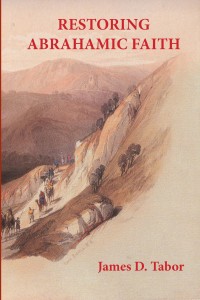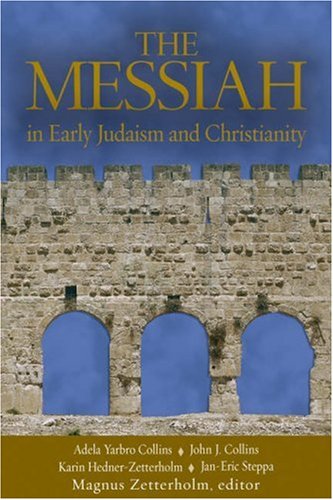[Originally posted December 9, 2013, reposted March 29, 2015; a timely clarification of where the idea of messiah originated.
This is second to the last subtopic, so please bear with us . . . there is so much to study (and check out) in James D. Tabor’s absolutely SOBER and thoroughly researched claims. As a resource center we are committed to sharing what we’ve learned and have embraced for ourselves, so we have chopped up a whole chapter in chewable doses and in doing so, even those who have already bought their copy and read through it are astonished as to how they missed details they rediscover in this series. Please check out these related posts;
- Revisit: The Messiahs – The Origin of the Messiah Idea
- The Messiahs – 2 – The Davidic Messiah
- The Messiahs – 3 – The Second Coming of YHVH
- The Messiahs – 4 – Restoring the Biblical Balance
- The Messiahs – 6 – Was Jesus the Nazarene the Messiah?
Continuing Chapter 4 of Restoring Abrahamic Faith . . . edited, reformatted, highlighted for this post.–Admin1.]
—————————-
Later Jewish and Christian traditions begin to focus on the Messiah as a heavenly figure, a cosmic Christ, who will be sent to earth from the heavenly realm.
[Footnote: We see the beginning development of this idea in the book of Enoch and in other writings from the 2nd century B.C.E. onward. See Jacob Neusner, ed. Judaism and Their Messiahs (Cambridge: Cambridge University Press, 1987), for a good scholarly discussion of the relevant materials. Many sections of the New Testament reflect this type of mystical speculation current among Jewish groups at this time. See the excellent summary articles on the Christology of Paul and John in the appendices to Hugh Schonfield, Those Incredible Christians (1968).]
There is a clear shift in these latter materials from the concrete and the earthly, to the speculative and the heavenly. We have seen that there is not a trace of any such idea in any of the Prophetic texts we have examined dealing with the Messiah, nor in the TORAH itself, which should always serve as the foundation of BIBLICAL FAITH. This should make us very wary of such texts and traditions, whether Jewish or Christian, most of which develop only late, from the Second Temple period onward (3rd century B.C.E. up through the early MIddle Ages).
How then did such ideas come about? We can attribute such developments to philosophical and mystical interests in the nature of God.
For example, the Logos doctrine contained in John 1:1-8 is not even a Christian invention. It was first developed by the Stoics centuries before the time of Jesus, and refined by the Jewish philosopher Philo of Alexandria who was in love with Hellenistic thought and language. The entire Logos doctrine attempts to deal with the problem of how God, who is perfect and unchanging, can deal with our transitory material world. Such traditions are quite esoteric, appealing to the Greek philosophical mind, but contributing nothing to the practical Hebraic/Biblical task of realizing the Kingdom of God in concrete history! Parallel discussions of this type were also carried out over the centuries among Jewish mystical and esoteric circles as witnessed in the Dead Sea Scrolls, the Pseudepigrapha, and the kabbalistic traditions now preserved in the Zohar.
The main text in the Hebrew Bible that has lent itself to such speculative developments comes from the book of Daniel:
I was watching in the night visions, and behold one like a son of man, coming with the clouds of heaven! He came to the Ancient of Days, and they brought him near before Him. Then to him was given dominion and glory and a kingdom, that all peoples, nations, and languages should serve him. His dominion is an everlasting dominion, which shall not pass away. And his kingdom the one which shall not be destroyed (Daniel 7:13-14).
During Second Temple times many groups began to identify this “son of man” (Aramaic—bar enosh) figure with the Davidic Messiah. The connection is obvious. He appears before God in heaven and is given rule and authority over an eternal Kingdom. Who else could this one be but the Messiah?
However, what these interpreters overlooked was that this text is part of a dream or vision given to Daniel.
It is full of symbols (beasts, horns, etc.) which all must be interpreted. However, the inspired interpretation is given in this very chapter. We do not have to speculate as to the identify of this mysterious “Son of Man” figure.
Daniel is plainly told in verse 27 that the “Son of Man” represents the people of the saints of the Most High” (7:22,27). In other words, like the idea of the “Servant” in Isaiah, it is a collective term that symbolically refers to the chasidim or “holy ones” who faithfully serve God and do not follow the ways of the “Beast” (successive Gentile powers that oppose the WAY of TORAH).
Clearly this symbol of the “son of Man” does not refer exclusively to any individual, but to the faithful people of God of all ages, the “Servant” of YHVH. There is an emphasis throughout the book on the persecuted faithful ones who resist pagan ways (11:32-33; 12:3). The setting up of the Kingdom is described as the direct action of God Himself (Daniel 2:44). The specific role of a Messiah is not mentioned in this text.
This language about the “Son of Man coming in the clouds” was removed from its symbolic, visionary, context and mistakenly taken to refer to an arrival of the Messiah from heaven (whether first or second coming). Such a view ignores the interpretation given in the prophecy itself, and misses the metaphorical meaning of the language. The “Son of Man coming in the clouds of heaven” clearly refers to the arrival of the Kingdom of God. It is not to be taken literally, as if the Messiah drops out of the sky.
There are no texts dealing with the Messiah in the entire Hebrew Bible that speak of him as anything other than—
- a human being,
- of the line of David,
- who rules as King over Israel and the nations.
The root idea of the Davidic Messiah
is based on God’s promises and faithfulness to David—
not on cosmic speculations about the heavenly world.
This is a vital point. In other words the Prophets do not develop their messianic ideas from speculations about the cosmos and ideas about heavenly beings or the nature of the Godhead. They are concerned with one dominant image, one that is wholly social and political—the realization of the promises to David and the fulfillment of the ideal reign of such a King. Even the language about the Messiah sitting at the “right hand of YHVH,” or as first born “Son of God” is obviously metaphorical (Psalm 2:7; 110:1). King David, as YHVH’s anointed, “sat at His right hand” and was called “son of God.”
Indeed, all the Kings of Israel were understood to be sitting on the “throne of YHVH” and were called “sons of YHVH” (1 Chronicles 29:23; 2 Samuel 7:14). Obviously, this does not mean they lived in heaven or that they were the divine offspring of a god.
This language is then applied ideally, by extension, to the Messiahs of the last days. It refers to the intimacy and powerful exaltation YHVH will give His anointed ones to carry out the rule of the Kingdom of God over all nations. It surely does not mean that the Davidic Messiah will literally sit up in the clouds of heaven, on a throne.



Reader Comments